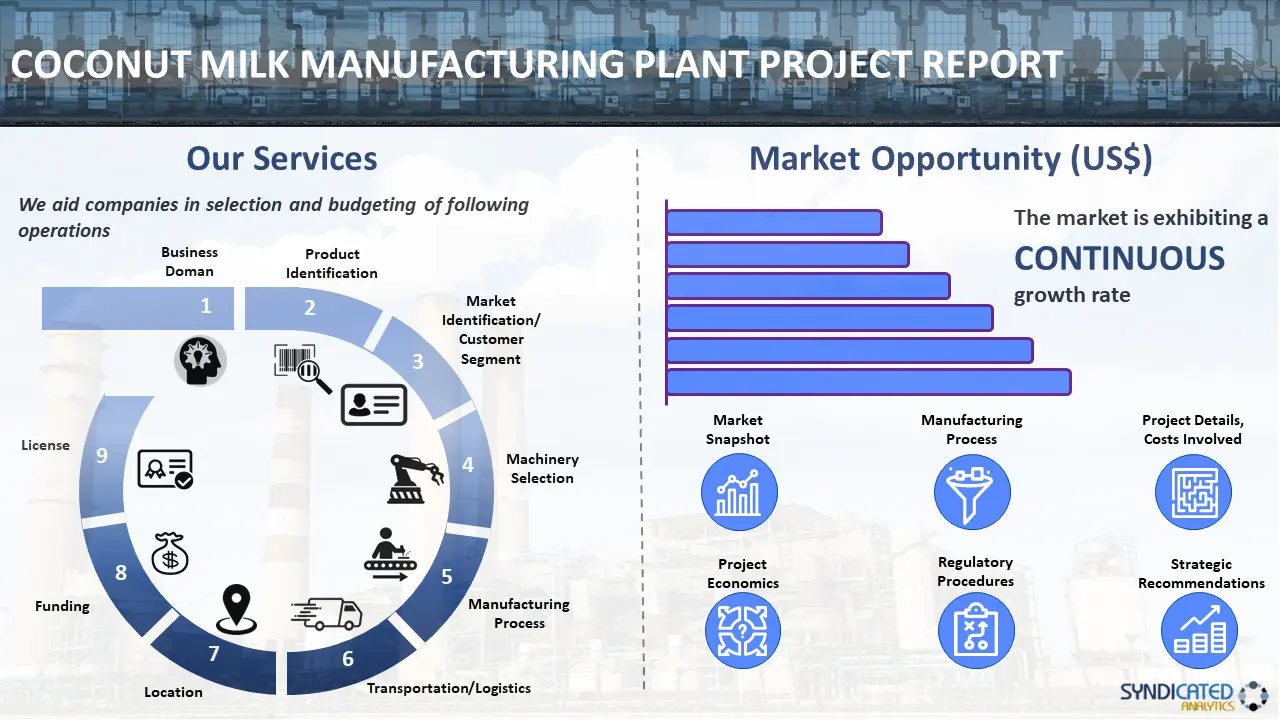
Coconut Milk Manufacturing Plant Project Report 2025 Edition
Report Coverage: Industry Analysis (Market Performance, Segments, Price Analysis, Outlook), Detailed Process Flow (Product Overview, Unit Operations, Raw Materials, Quality Assurance), Requirements and Cost (Machinery, Raw Materials, Packaging, Transportation, Utility, Human Resource), Project Economics (Capital Investments, Operating Costs, Profit Projections, Financial Analysis, Revenue), and Investment Opportunities
Report Overview:
Syndicated Analytics report, titled “Coconut Milk Manufacturing Plant Project Report 2025 Edition: Industry Analysis (Market Performance, Segments, Price Analysis, Outlook), Detailed Process Flow (Product Overview, Unit Operations, Raw Materials, Quality Assurance), Requirements and Cost (Machinery, Raw Materials, Packaging, Transportation, Utility, Human Resource), Project Economics (Capital Investments, Operating Costs, Profit Projections, Financial Analysis, Revenue), and Investment Opportunities,” provides a complete roadmap for setting up a coconut milk manufacturing plant. It covers a comprehensive market overview to micro-level information such as unit operations involved, raw material requirements, utility requirements, infrastructure requirements, machinery and technology requirements, manpower requirements, packaging requirements, transportation requirements, etc. The report provides detailed insights into project economics, including capital investments, project funding, operating expenses, income and expenditure projections, fixed costs vs. variable costs, direct and indirect costs, expected ROI and net present value (NPV), profit and loss account, financial analysis, etc. This report is a must-read for entrepreneurs, investors, researchers, consultants, and business strategists with a stake in the coconut milk industry. It provides an in-depth analysis of the industry's current state and future potential, offering valuable insights for decision-making and strategy development. The report is an indispensable resource that offers a detailed examination of the coconut milk industry. It is a valuable tool for anyone seeking to establish a foothold in this dynamic sector.

Coconut milk, derived from the flesh of mature coconuts, is a key ingredient in various culinary traditions, valued for its versatility and nutritional benefits. The process of making coconut milk starts with shredding the coconut flesh, which is then blended with water. This mixture is subsequently strained to produce the creamy, milky fluid known as coconut milk. Coconut milk serves a multitude of culinary purposes, making it a staple ingredient in various cuisines. Its uses include adding creaminess to curries, soups, and stews, as well as being a key component in tropical desserts and beverages like piña coladas. One of its notable advantages is its rich and creamy texture, which makes it an excellent dairy alternative for vegans and individuals with lactose intolerance. Additionally, coconut milk is a source of essential nutrients such as vitamins C and E, as well as minerals like potassium and magnesium. Its naturally occurring fats provide a source of healthy energy and can contribute to a feeling of satiety. Furthermore, its unique flavor profile adds depth and richness to dishes, making it a sought-after ingredient in both sweet and savory recipes. Coconut milk is available in several types, ranging from thick and creamy to light and thin, such as full-fat coconut milk and light coconut milk.
Market Trends/Drivers:
The global coconut milk market is influenced by a diverse set of drivers, such as the increasing awareness of health benefits associated with coconut milk, such as its high nutrient content and lactose-free nature. This is further supported by the rising popularity of Asian cuisine globally, where coconut milk is a staple ingredient. Moreover, the growing vegan and plant-based lifestyle trend is significantly driving the adoption of coconut milk as a dairy alternative, which is stimulating the market growth. In line with this, advancements in packaging technology have enhanced the shelf life and convenience of coconut milk products, making them more appealing to consumers, which is providing a thrust to the market growth. Furthermore, the expansion of distribution channels, including online platforms, has made coconut milk more accessible worldwide, further accelerating the market growth. Additionally, an increase in marketing and branding efforts by key players is enhancing consumer awareness and product visibility, which is providing a thrust to the market growth. Apart from this, the diversification of coconut milk products, including flavored and fortified versions, the rise in lactose intolerance among the global population, and the growing food and beverage industry are other growth-inducing factors.
The project report covers the following aspects of the coconut milk market:
- Market Snapshot:
- Market Performance
- Market Breakup by Segment
- Market Breakup by Region
- Price Trends
- Impact of COVID-19
- Market Outlook
- Manufacturing Process:
- Product Overview
- Detailed Process Flow
- Unit Operations Involved
- Mass Balance and Raw Material Requirements
- Project Details, Requirements and Costs Involved:
- Land, Location and Site Development
- Plant Layout
- Machinery Requirements and Expenditures
- Raw Material Requirements and Expenditures
- Packaging Requirements and Expenditures
- Transportation Requirements and Expenditures
- Utility Requirements and Expenditures
- Manpower Requirements and Expenditures
- Project Economics
- Capital Investments
- Operating Costs
- Expenditure Projections
- Revenue Projections
- Profit Projections
- Financial Analysis
- Regulatory Procedures and Approval
- Key Success and Risk Factors
Report Scope:
| Report Features | Details |
|---|---|
| Product Name | Coconut Milk |
| Report Coverage | Detailed Process Flow: Unit Operations Involved, Quality Assurance Criteria, Technical Tests, Mass Balance, and Raw Material Requirements Land, Location and Site Development: Selection Criteria and Significance, Location Analysis, Project Planning and Phasing of Development, Environmental Impact, Land Requirement and Costs Plant Layout: Importance and Essentials, Layout, Factors Influencing Layout Plant Machinery: Machinery Requirements, Machinery Costs, Machinery Suppliers (Provided on Request) Raw Materials: Raw Material Requirements, Raw Material Details and Procurement, Raw Material Costs, Raw Material Suppliers (Provided on Request) Packaging: Packaging Requirements, Packaging Material Details and Procurement, Packaging Costs, Packaging Material Suppliers (Provided on Request) Other Requirements and Costs: Transportation Requirements and Costs, Utility Requirements and Costs, Energy Requirements and Costs, Water Requirements and Costs, Human Resource Requirements and Costs Project Economics: Capital Costs, Techno-Economic Parameters, Income Projections, Expenditure Projections, Product Pricing and Margins, Taxation, Depreciation Financial Analysis: Liquidity Analysis, Profitability Analysis, Payback Period, Net Present Value, Internal Rate of Return, Profit and Loss Account, Uncertainty Analysis, Sensitivity Analysis, Economic Analysis Other Analysis Covered in The Report: Market Trends and Analysis, Market Segmentation, Market Breakup by Region, Price Trends, Competitive Landscape, Regulatory Landscape, Strategic Recommendations, Case Study of a Successful Venture |
| Currency | US$ (Information can also be provided in the local currency) |
| Pricing and Purchase Options | Single User License: US$ 3450 Five User License: US$ 4450 Corporate User License: US$ 5450 |
| Customization Scope | The report can also be customized based on the requirement of the customer |
| Post-Sale Analyst Support | 12-14 Weeks |
| Delivery Format | PDF and Excel through email (We can also provide the editable version of the report in PPT/Word format on special request) |
Key Questions Answered in This Report?
- What are the key success and risk factors in the coconut milk industry?
- How has the coconut milk market performed so far and how will it perform in the coming years?
- What is the structure of the coconut milk industry and who are the key players?
- What are the various unit operations involved in a coconut milk manufacturing plant?
- What is the total size of land required for setting up a coconut milk manufacturing plant?
- What are the machinery requirements for setting up a coconut milk manufacturing plant?
- What are the raw material requirements for setting up a coconut milk manufacturing plant?
- What are the utility requirements for setting up a coconut milk manufacturing plant?
- What are the manpower requirements for setting up a coconut milk manufacturing plant?
- What are the infrastructure costs for setting up a coconut milk manufacturing plant?
- What are the capital costs for setting up a coconut milk manufacturing plant?
- What are the operating costs for setting up a coconut milk manufacturing plant?
- What should be the pricing mechanism of coconut milk?
- What will be the income and expenditures for a coconut milk manufacturing plant?
- What is the time required to break-even?
Need a Customized Project Report?
Although we have tried to make the report as comprehensive as possible, we believe that every stakeholder may have their specific requirements. In view of this, we can customize the report based on your particular needs. You can share your business requirements with our consultants, and we will provide you a tailored scope. Some of the common customizations that our clients request us include:
- The report can be customized based on the country/region that you plan to set up your plant.
- The manufacturing capacity of the plant can be customized based on your requirements.
- Machinery suppliers and costs can be customized based on your requirements.
- Any additions to the current scope can also be provided based on your requirements.
Why buy Syndicated Analytics reports?
- Our reports provide stakeholders insights into the viability of a business venture, allowing them to take informed business decisions.
- We have a strong network of consultants and domain experts in 100+ countries across North America, Europe, Asia Pacific, South America, Africa, and the Middle East.
- We have a strong database of equipment and raw material suppliers across all major continents.
- We regularly track and update land costs, construction costs, Utility costs, labour costs, etc across 100+ countries around the globe
- We are the trusted business partners to the world’s leading corporates, governments, and institutions. Our client list ranges from small and start-up businesses to fortune 500 companies
- Our strong in-house team of engineers, statisticians, modelling experts, charted accountants, architects, etc. have been instrumental in building, expanding, and optimizing sustainable manufacturing plants across the globe.
Purchase Options
Ask For Customization
Personalize this research
Triangulate with your own data
Get data as per your format and definition
Gain a deeper dive on a specific application, geography, customer or competitor
Any level of personalization
Get in Touch
Call us on
US: +1-213-316-7435
Uk: +44-20-8040-3201
Drop us an email at
sales@syndicatedanalytics.com